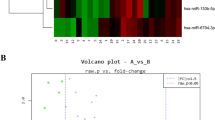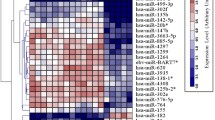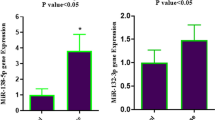Abstract
The characterization of atherosclerosis as a chronic inflammatory disease has triggered extensive research worldwide to dissect the pro- and anti-inflammatory, cellular as well as molecular mechanisms governing the pathogenesis of this dreadful disease. Though several microRNAs have been shown to play crucial role in regulating lipid metabolism and inflammation, we are far from resolving the role of epigenomic signals in etiology of coronary heart disease (CHD). The present study was addressed to understand the role of a novel microRNA, miR-2909, in the regulation of genes involved in the initiation and progression of human coronary occlusion. Peripheral blood mononuclear cells were isolated from human CHD subjects at various stages of coronary occlusion (n = 80) and their corresponding normal healthy counterparts (n = 20). Various experimental strategies involving gene expression and silencing, reporter plasmid assays, and flow cytometric analysis were blend together to address the current problem. The present study shows for the first time that the blood cellular miR-2909 expression increases with the severity of coronary occlusion, exhibiting a strong positive correlation (r = 0.943 at p < 0.01). Further, miR-2909 was shown to regulate genes involved in inflammation, immunity, and oxLDL uptake, thereby contributing significantly to the initiation and progression of CHD patho-physiological process. Based upon these results, we propose that miR-2909 RNomics may be a step forward in understanding human CHD at the epigenomic level and can be exploited for designing new therapeutic strategies as well as diagnostic and prognostic markers for this disease in future.










Similar content being viewed by others
References
Kutuk O, Basaga H (2003) Inflammation meets oxidation: NF-kappaB as a mediator of initial lesion development in atherosclerosis. Trends Mol Med 9:549–557
Michael DR, Ashlin TG, Buckley ML, Ramji DP (2012) Liver X receptors, atherosclerosis and inflammation. Curr Atheroscler Rep 14:284–293
Zelcer N, Tontonoz P (2006) Liver X receptors as integrators of metabolic and inflammatory signaling. J Clin Invest 116:607–614
Joseph SB, Castrillo A, Laffitte BA, Mangelsdorf DJ, Tontonoz P (2003) Reciprocal regulation of inflammation and lipid metabolism by liver X receptors. Nat Med 9:213–219
de Winther MP, Kanters E, Kraal G, Hofker MH (2005) Nuclear factor kappaB signaling in atherogenesis. Arterioscler Thromb Vasc Biol 25:904–914
Ross R (1999) Atherosclerosis—an inflammatory disease. N Engl J Med 340:115–126
Dave VP, Kaul D, Sharma Y, Bhattacharya R (2009) Functional genomics of blood cellular LXR-alpha gene in human coronary heart disease. J Mol Cell Cardiol 46:536–544
Madrigal-Matute J, Rotllan N, Aranda JF, Fernandez-Hernando C (2013) MicroRNAs and atherosclerosis. Curr Atheroscler Rep 15:322
Vickers KC, Remaley AT (2010) MicroRNAs in atherosclerosis and lipoprotein metabolism. Curr Opin Endocrinol Diabetes Obes 17:150–155
Chen KC, Hank Juo SH (2012) MicroRNAs in atherosclerosis. Kaohsiung J Med Sci 28:631–640
Kaul D, Hussain A (2009) Cellular AATF gene encodes a novel miRNA that can contribute to HIV-1 latency. Indian J Biochem Biophys 46:237–240
Sharma M, Sharma S, Arora M, Kaul D (2013) Regulation of cellular Cyclin D1 gene by arsenic is mediated through miR-2909. Gene 522:60–64
Kaul D, Sasikala M, Raina A (2012) Regulatory role of miR-2909 in cell-mediated immune response. Cell Biochem Funct 30:500–504
Visvikis-Siest S, Marteau JB, Samara A, Berrahmoune H, Marie B, Pfister M (2007) Peripheral blood mononuclear cells (PBMCs): a possible model for studying cardiovascular biology systems. Clin Chem Lab Med 45:1154–1168
Ritchie ME (1998) Nuclear factor-kappaB is selectively and markedly activated in humans with unstable angina pectoris. Circulation 98:1707–1713
World Medical Association (2002) World Medical Association Declaration of Helsinki: ethical principles for medical research involving human subjects. J Postgrad Med 48:206–208
Gensini GG (1983) A more meaningful scoring system for determining the severity of coronary heart disease. Am J Cardiol 51:606
Rehmsmeier M, Steffen P, Hochsmann M, Giegerich R (2004) Fast and effective prediction of microRNA/target duplexes. RNA 10:1507–1517
Xuan Z, Zhao F, Wang J, Chen G, Zhang MQ (2005) Genome-wide promoter extraction and analysis in human, mouse, and rat. Genome Biol 6:R72
Bryne JC, Valen E, Tang MH, Marstrand T, Winther O, da Piedade I, Krogh A, Lenhard B, Sandelin A (2008) JASPAR, the open access database of transcription factor-binding profiles: new content and tools in the 2008 update. Nucleic Acids Res 36:D102–D106
Heinemeyer T, Wingender E, Reuter I, Hermjakob H, Kel AE, Kel OV, Ignatieva EV, Ananko EA, Podkolodnaya OA, Kolpakov FA, Podkolodny NL, Kolchanov NA (1998) Databases on transcriptional regulation: TRANSFAC, TRRD and COMPEL. Nucleic Acids Res 26:362–367
Boyum A (1968) Isolation of mononuclear cells and granulocytes from human blood. Isolation of monuclear cells by one centrifugation, and of granulocytes by combining centrifugation and sedimentation at 1×g. Scand J Clin Lab Invest Suppl 97:77–89
Laemmli UK (1970) Cleavage of structural proteins during the assembly of the head of bacteriophage T4. Nature 227:680–685
Lowry WE, Richter L, Yachechko R, Pyle AD, Tchieu J, Sridharan R, Clark AT, Plath K (2008) Generation of human induced pluripotent stem cells from dermal fibroblasts. Proc Natl Acad Sci USA 105:2883–2888
Jono H, Lim JH, Chen LF, Xu H, Trompouki E, Pan ZK, Mosialos G, Li JD (2004) NF-kappaB is essential for induction of CYLD, the negative regulator of NF-kappaB: evidence for a novel inducible autoregulatory feedback pathway. J Biol Chem 279:36171–36174
Hutti JE, Shen RR, Abbott DW, Zhou AY, Sprott KM, Asara JM, Hahn WC, Cantley LC (2009) Phosphorylation of the tumor suppressor CYLD by the breast cancer oncogene IKKepsilon promotes cell transformation. Mol Cell 34:461–472
Reiley W, Zhang M, Wu X, Granger E, Sun SC (2005) Regulation of the deubiquitinating enzyme CYLD by IkappaB kinase gamma-dependent phosphorylation. Mol Cell Biol 25:3886–3895
Takami Y, Nakagami H, Morishita R, Katsuya T, Hayashi H, Mori M, Koriyama H, Baba Y, Yasuda O, Rakugi H, Ogihara T, Kaneda Y (2008) Potential role of cylindromatosis (CYLD) as a deubiquitinating enzyme in vascular cells. Am J Pathol 172:818–829
Kaul D, Baba MI (2005) Genomic effect of vitamin ‘C’ and statins within human mononuclear cells involved in atherogenic process. Eur J Clin Nutr 59:978–981
Baranowski M (2008) Biological role of liver X receptors. J Physiol Pharmacol 59(Suppl 7):31–55
Sharma N, Lu Y, Zhou G, Liao X, Kapil P, Anand P, Mahabeleshwar GH, Stamler JS, Jain MK (2012) Myeloid Kruppel-like factor 4 deficiency augments atherogenesis in ApoE−/− mice—brief report. Arterioscler Thromb Vasc Biol 32:2836–2838
Alaiti MA, Orasanu G, Tugal D, Lu Y, Jain MK (2012) Kruppel-like factors and vascular inflammation: implications for atherosclerosis. Curr Atheroscler Rep 14:438–449
Sakai M, Kobori S, Miyazaki A, Horiuchi S (2000) Macrophage proliferation in atherosclerosis. Curr Opin Lipidol 11:503–509
Rekhter MD, Gordon D (1995) Active proliferation of different cell types, including lymphocytes, in human atherosclerotic plaques. Am J Pathol 147:668–677
Zhang W, Geiman DE, Shields JM, Dang DT, Mahatan CS, Kaestner KH, Biggs JR, Kraft AS, Yang VW (2000) The gut-enriched Kruppel-like factor (Kruppel-like factor 4) mediates the transactivating effect of p53 on the p21WAF1/Cip1 promoter. J Biol Chem 275:18391–18398
Chistiakov DA, Sobenin IA, Orekhov AN (2013) Regulatory T cells in atherosclerosis and strategies to induce the endogenous atheroprotective immune response. Immunol Lett 151:10–22
Klingenberg R, Gerdes N, Badeau RM, Gistera A, Strodthoff D, Ketelhuth DF, Lundberg AM, Rudling M, Nilsson SK, Olivecrona G, Zoller S, Lohmann C, Luscher TF, Jauhiainen M, Sparwasser T, Hansson GK (2013) Depletion of FOXP3+ regulatory T cells promotes hypercholesterolemia and atherosclerosis. J Clin Invest 123:1323–1334
Ammirati E, Cianflone D, Banfi M, Vecchio V, Palini A, De Metrio M, Marenzi G, Panciroli C, Tumminello G, Anzuini A, Palloshi A, Grigore L, Garlaschelli K, Tramontana S, Tavano D, Airoldi F, Manfredi AA, Catapano AL, Norata GD (2010) Circulating CD4+ CD25hiCD127lo regulatory T-Cell levels do not reflect the extent or severity of carotid and coronary atherosclerosis. Arterioscler Thromb Vasc Biol 30:1832–1841
Buckner JH (2010) Mechanisms of impaired regulation by CD4(+)CD25(+)FOXP3(+) regulatory T cells in human autoimmune diseases. Nat Rev Immunol 10:849–859
Banerjee A, Vasanthakumar A, Grigoriadis G (2013) Modulating T regulatory cells in cancer: how close are we? Immunol Cell Biol 91:340–349
Facciabene A, Motz GT, Coukos G (2012) T-regulatory cells: key players in tumor immune escape and angiogenesis. Cancer Res 72:2162–2171
Ramos KS, Partridge CR (2005) Atherosclerosis and cancer: flip sides of the neoplastic response in mammalian cells? Cardiovasc Toxicol 5:245–255
Ross JS, Stagliano NE, Donovan MJ, Breitbart RE, Ginsburg GS (2001) Atherosclerosis: a cancer of the blood vessels? Am J Clin Pathol 116(Suppl):S97–S107
Wolf AM, Wolf D, Steurer M, Gastl G, Gunsilius E, Grubeck-Loebenstein B (2003) Increase of regulatory T cells in the peripheral blood of cancer patients. Clin Cancer Res 9:606–612
Caligiuri G, Nicoletti A (2010) Tregs and human atherothrombotic diseases: toward a clinical application? Arterioscler Thromb Vasc Biol 30:1679–1681
Ha TY (2011) The role of miRNAs in regulatory T cells and in the immune response. Immune Netw 11:11–41
Acknowledgments
We would like to acknowledge Dr. Anoop Kumar for carrying out immunophenotyping analysis. We also thank W. E. Lowry and K. Plath for the KLF4 expression plasmid and Ms. M. Arora for editing the manuscript, and assistance with KLF4 cloning. This work was supported by Indian Council of Medical Research (ICMR), New Delhi, India.
Conflict of interest
None declared.
Author information
Authors and Affiliations
Corresponding author
Rights and permissions
About this article
Cite this article
Arora, M., Kaul, D. & Sharma, Y.P. Human coronary heart disease: importance of blood cellular miR-2909 RNomics. Mol Cell Biochem 392, 49–63 (2014). https://doi.org/10.1007/s11010-014-2017-3
Received:
Accepted:
Published:
Issue Date:
DOI: https://doi.org/10.1007/s11010-014-2017-3




